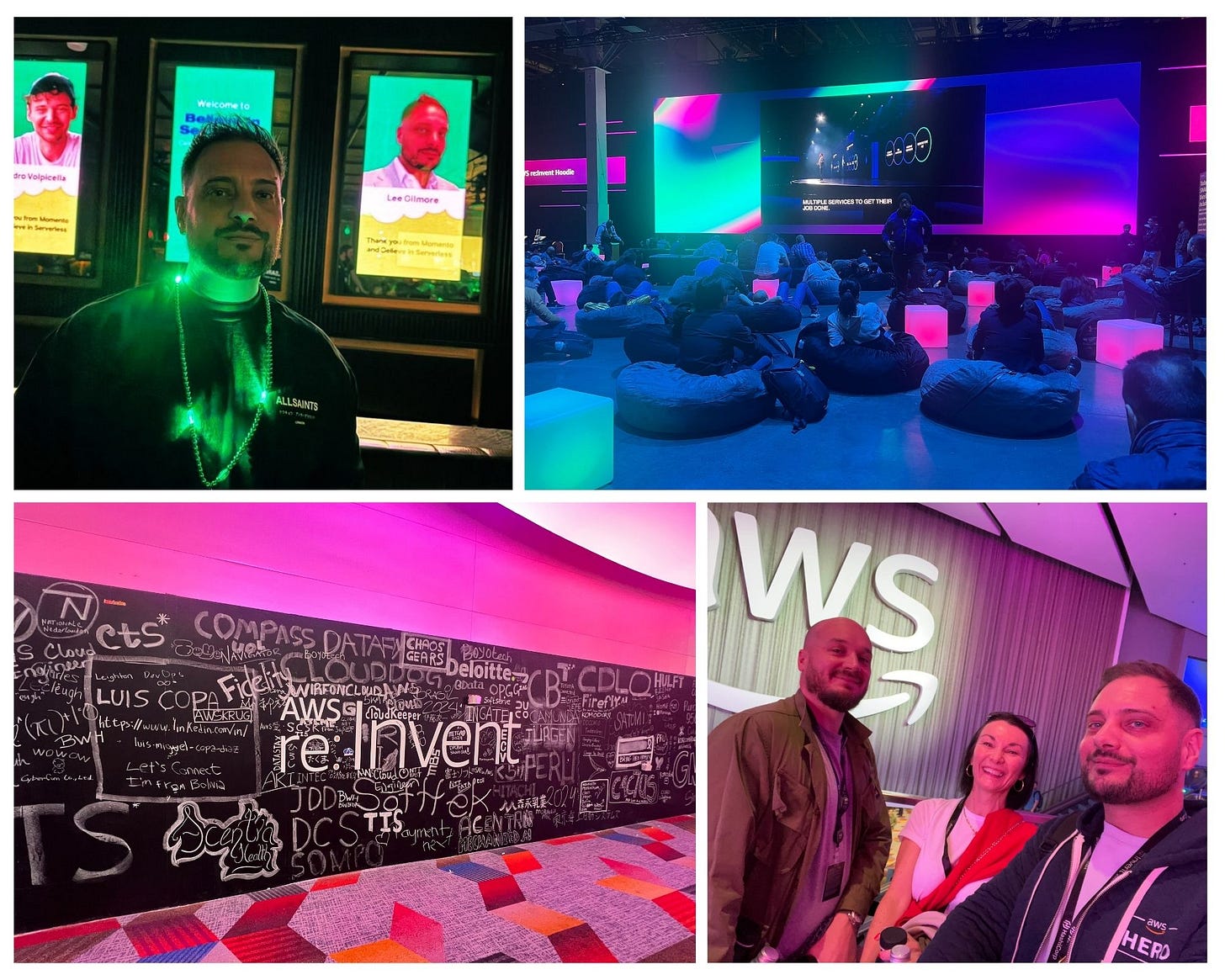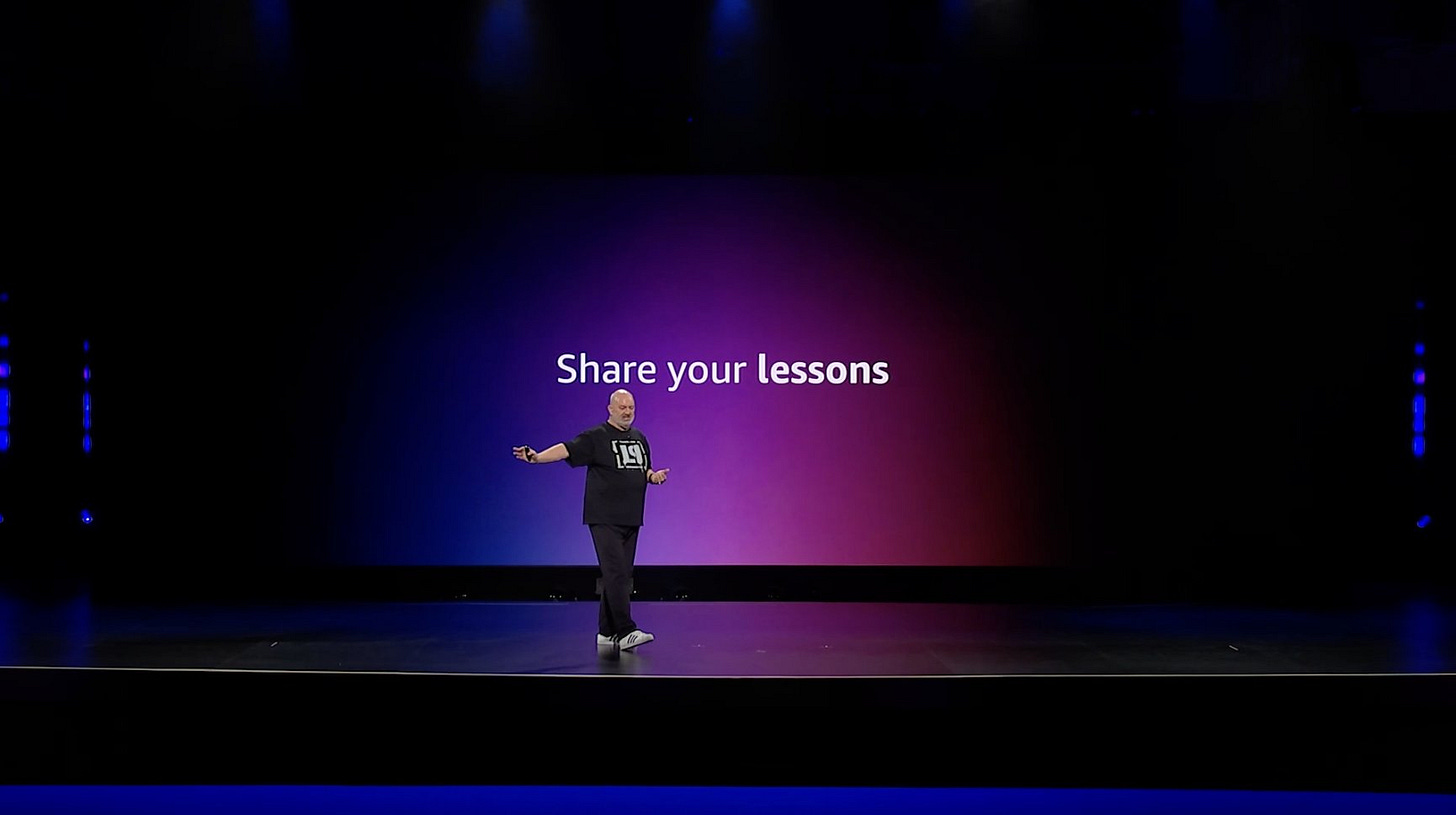#14 Re:Invent is Here! 🎊
In this week’s issue, we have more great insights from our Expert of the week AWS Serverless Hero Filip Pýrek, the spotlight falls on author David Anderson, latest releases, news and more!
Welcome
In last week’s article, our serverless expert of the week was AWS Serverless Hero Marcin Sodkiewicz, the spotlight fell on AWS Serverless Hero Luc van Donkersgoed, and we had some great contributions from the community!
This week, our serverless expert of the week is AWS Serverless Hero Filip Pýrek, our spotlight falls on author and serverless expert David Anderson, we congratulate AWS Hero Rossana Suarez for the Go Build Award achievement, we look at the latest exciting serverless news, discuss re:Invent, service updates, and more!
This week’s newsletter is sponsored by Leighton.
A Glimpse into My Week 🎤
This week I am at Re:Invent in Las Vegas! What a fantastic week meeting new and old friends from across the globe! 🌎
This has been my first re:Invent as an AWS Serverless Hero, and its been amazing to connect with so many people in the community, attend the 10th Anniversary party of Lambda and ECS, learn about the latest service releases, and watch some of the Believe In Serverless talks in the community lounge!
Another stand out moment was Amazon CTO, Dr Werner Vogels giving a shout-out to the Heroes programme with the statement “Listen to the Heroes“ - huge validation of the amazing work of Farrah, Taylor, Ross, and team 👏🏼
📰 Articles that caught the eye
⭐ The highlight for me this week was the article by Jatin Mehrotra covering Aurora DSQL. This service is a game changer for many!
Adil Ansari covers Getting Started with Amazon Transcribe in Easy Steps.
Jatin Mehrotra is really quick to look at Unlocking Aurora DSQL with AWS Lambda.
Serverless self-service IoT certificate management - Part 1 by Jimmy Dahlqvist.
A Big Thank You! 🙌🏼💜
As we continue with the growth of the Serverless Advocate Newsletter, I wanted to say a huge thanks to our community, and the people that are actively answering our 3 Serverless Expert questions of the Week!
So far we have had the following amazingly talented people give up their time, from Serverless Specialist Architects, to AWS Community Builders, to AWS Serverless Heroes, authors and more! There are more exciting contributions coming up in future weeks too! (stay tuned!)
Ran Isenberg (AWS Serverless Hero)
Luciano Mammino (AWS Serverless Hero)
Benjamen Pyle (AWS Community Builder)
Danielle Heberling (AWS Serverless Hero)
Omid Eidivandi (AWS Community Builder)
Steve Morland (AWS Community Builder)
James Eastham (Developer Advocate at Datadog)
Sam Williams (AWS Community Builder)
Jimmy Dahlqvist (AWS Serverless Hero)
Sheen Brisals (AWS Serverless Hero)
Darryl Ruggles (Cloud Solutions Architect)
Luca Mezzalira (AWS Principal Serverless Specialist Solutions Architect)
Marcin Sodkiewicz (AWS Serverless Hero)
Filip Pýrek (AWS Serverless Hero)
Are you interested in giving your insights? Please reach out to me! 🙌🏼
🎓 Ask the Expert
Each week, I ask a different serverless expert the same three questions to get their personal insights - this week, we have AWS Serverless Hero Filip Pýrek:
1. What is one common mistake you see teams making when implementing serverless solutions, and how can they avoid it?
The biggest mistake I see is the mindset. The teams must realise that Serverless is also about shifting the complexity from application level to the infrastructure level. Using lift-and-shift never works.
2. Which serverless tool or service are you most excited about right now, and why?
I’m most excited about SST. The SST v2 was great and made big improvements to the AWS CDK developer experience. But both myself and the SST team, we see that CloudFormation has a lot of limitations. Like speed of deployment, single-region support per stack, etc. So SST v3 is now switching to Pulumi (which uses Terraform providers under the hood) and shifts the developer experience to yet another level by providing developers the ability to connect the best services from different cloud/service providers.
3. What is your favourite trick or tip when working with serverless that the readers may find interesting?
1. SST live lambda development is great for (not only for lambda) debugging.
2. For company-wide or shared infrastructure use Pulumi or Terraform instead of CloudFormation. Especially due to cross-region and cross-account features.
3. Have a growth mindset, learn VPC. Don’t be afraid of it just because you don’t understand it. You can only benefit from it.
Themes from the Experts! 🧠🤖
Every so often I will put the answers to the three weekly serverless questions through generative AI using Amazon Bedrock to see if there are any trends in the experts answers, and then I summarise in my own words:
Common Mistakes in Serverless Implementations: The biggest takeaway here is that the most frequent issues come from teams having more traditional mindsets, and not embracing or educating themselves on the serverless paradigm, whilst treating serverless services like traditional architectures of days of old. The other key area is failing to consider production readiness (e.g., observability, resilience, and testing). There is also a key trend in the need for education on the paradigm shift toward modular, event-driven, and stateless systems while embracing failure management and scalability.
Exciting Serverless Tools and Services: Most of the experts have highlighted the evolution of new exciting services that sit outside of (but available through or integrate with) AWS, like Cloudflare, Momento and Neon as key examples. Internal to AWS, the experts are most excited about the EDA services and services that integrate tightly with them, for example Amazon EventBridge, Amazon StepFunctions, AppSync Events etc.
What are your thoughts on above? Do you agree?
🚀 New Releases
There have been so so many new releases this week with it being re:Invent, but the major highlight has to be Amazon Aurora DSQL for me! This is a real game changer in my opinion!
New Amazon DynamoDB zero-ETL integration with Amazon SageMaker Lakehouse.
Introducing Amazon Nova: Frontier intelligence and industry leading price performance.
Introducing multi-agent collaboration capability for Amazon Bedrock (preview).
Announcing Amazon S3 Metadata (Preview) – Easiest and fastest way to manage your metadata.
Amazon DynamoDB global tables previews multi-Region strong consistency.
Announcing Amazon S3 Tables – Fully managed Apache Iceberg tables optimized for analytics workloads.
Introducing queryable object metadata for Amazon S3 buckets (preview).
Amazon Bedrock Marketplace: Access over 100 foundation models in one place.
🔥 Tip: Check out https://aws-news.com/ for the very latest up to date serverless releases as they happen, created by the talented AWS Serverless Hero Luc van Donkersgoed.
💡 Quick Hints & Tips
Each week I share quick hints or tips based on things I notice in day-to-day engineering life:
⭐ [Tip 1] Quite often when working with DynamoDB it is key that the engineering team understands the access patterns of the table, especially with single-table design, composite keys, adjacent list patterns etc - this can be super hard to visualise purely in the mind!
One way I usually do this with my teams is to generate a conceptual ERD using Mermaid syntax through generative AI (above); as well as the table definitions as markdown which can be embedded into the solutions README file in GitHub (example below).
This is a great way to make it visible in my experience!
⭐ [Tip 2] - One method which many people forget about when caching in serverless is doing this outside of the Lambda function handler, which is a great option for when we may want to cache values which don’t change often, and we want to decrease costs and increase speed. This works essentially by setting a variable outside of the handler function which is then cached across invocations, and we can get clever with using cache busting approaches with epoch date-time strings etc
Here is a quick article in a series I wrote on caching strategies in Serverless.
✖️ Social of the Week
This weeks social was a no brainer for me, seeing AWS Hero Rossana Suarez win Dr Werner Vogels “Go Build Award”! As a Dad of two young girls, I love to see people championing women in tech, paving the way for a better future for our loved ones!
Congratulations again Rossana! Very well deserved!
🎙️ YouTube & Podcasts
Best Practices for Serverless Developers (SVS401) by Ran Isenberg and Julian Wood.
Future of EDA Panel with Various - Pogosova, Shea, Armstrong, Gasch, DeBrie, Wood & Johnson.
Asynchronous frontends: Building seamless event-driven experiences (API305) with Joshua Kahn.
Complexity is the Gotcha of Event-driven Architecture with David Boyne.
🗳️ Poll of the Week
In last weeks poll we asked the question “Do you use Private Amazon API Gateways on AWS?“. Interestingly, 44% said yes, and 56% said no. I would expect with the recent service improvements with custom domain names and EventBridge and StepFunctions integration with Private APIs, we may see this increase; especially across enterprises.
This week, we ask the question “How do the majority of your cloud solutions run as standard?“. What is your standard, minimum, or “go-to” when releasing software in the cloud?
I would love to hear your thoughts using the comments button below!
🗣️ Inspirational Quotes and Thoughts
This week’s quote comes from Author Efrat Goldratt-Ashlag:
“There is no sense in talking about the solution before we agree on the problem, and no sense talking about the implementation steps before we agree on the solution”
- Efrat Goldratt-Ashlag
The reason I love this quote is that there is always a tradeoff between up front design in software engineering and pure agility, and its often a cause of contention for many teams and organisations in my experience!
My own take: I personally like very lightweight design documents stating the agreed problem statement, what is out of scope for first iteration, the high-level architecture, expected costs etc - with the document usually created during spikes and discovery as we go, so the team has a shared north star vision and we keep it agile - very iterative and document updated as we learn more. Without this, I have seen some very much ‘tech driven’ agile projects that don’t meet the expectations of the stakeholders as the solution to the problem statement is not understood or delivered.
Where is your line in the sand with the tradeoffs between the two?
⭐ Spotlight
This week’s spotlight falls on serverless expert, author, and architect David Anderson!
Dave has done a great deal for our community between his co-authored book, ‘The Value Flywheel Effect’, his many fantastic talks at various conferences, articles, his podcast ‘Serverless Craic’, and much much more. I have also had the pleasure of chatting in person on many occasions, deep diving into great discussions on all things enterprise architecture and EDA!
Thank you for all you do for our community!
👋🏼 Wrapping Up
Thank you for reading the latest Serverless Advocate Newsletter!
If you want to find out a little more about me, please have a look at:
https://www.serverlessadvocate.com/
See you next time,
Lee














